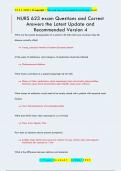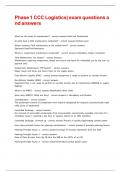2 0 2 4 /2025 | © copyright | This work may not be copied for profit gain Excel!
NURS 623 exam Questions and Correct
Answers the Latest Update and
Recommended Version 4
What are the typical demographics of a patient with MS (what type of person does this
disease normally effect)
→ Young, caucasion female of eastern European desent
At the onset of alzheimers, what category of medications should be initiated
→ Cholinesterase inhibitors
What factors contribute to a patient being high risk for falls
→ History of falls, medications, vision impairment, heat rate/rhythm abnormalities,
footwear issues, home environment, gait/mobility issues, poor reflexes.
What classes of antibiotics would need to be renally dosed with a patient with impaired renal
function
→ Vanc, floroquinolones, and aminoglycosides
What does FAST mean when assessing for s/s of stroke
→ Face, Arms, Speech, Time
How does an absence seizure present (symptoms)
→ Sudden onset, blank stare (upward rotation of eye), activity stops and appears
transfixed, few seconds to 1 min
What is the difference between delirium and dementia
1|Page| GradeA+ | 2 0 0 2 5
, 2 0 2 4 /2025 | © copyright | This work may not be copied for profit gain Excel!
→ First involves underlying acute cause, abrupt onset, hours to days, reversible,
hallucination, incoherent speech, and confusion. The second can have various causes,
gradual change with mental status, months to years, progressive to irreversible
(speech, memory, mood, and judgment).
What are the risk factors for development of a pressure ulcer?
→ Elderly are most at risk population. Thin skin and less subcutaneous fat along with less
movement create and environment for pressure ulcers.
What are the red flag signs of a patient with low back pain.
→ Hx trauma, fever, unexplained weight loss, hx cancer, incontinence, long term steroid
use, parental drug abuse, intense localized pain, inability to find comfortable position,
Cadua Equina Syndrome. Always assess radiation of pain, bowel, bladder.
What are the common bacterial organisms associated with bacterial meningitis.
→ Neisseria meningitides (high mortality), haemophilus influenza type B, streptococcus
pneumoniae most common
What are the s/s of alzheimers?
→ Presence of dementia by clinical exam and MMSE (mini-mental state exam) deficit in 2
or more areas of cognition, progressive worsening of memory and cognitive function
without disturbed consciousness and absence of systemic illness/other brain disease.
Impaired ability to learn new info along with disturbance in language, function, or
perception.
What are the s/s of Parkinsons?
→ Age >60, tremor at rest (pill rolling), rigidity, bradykinesia, masked face, stopped
posture, shuffling gait, arching (limbs, neck, back), decrease facial dexterity,
dysphagia, orthostatic hypotension, anosmia, depression, cognitive impairment,
freezing phenomenon, cogwheeling, postural instability (advanced disease)
What are the s/s of GB?
1|Page| GradeA+ | 2 0 0 2 5






